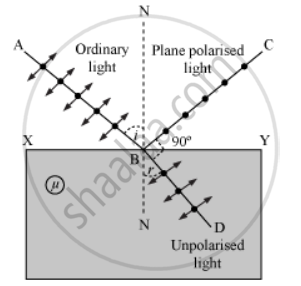Advertisements
Advertisements
Question
Show using a proper diagram how unpolarised light can be linearly polarised by reflection from a transparent glass surface.
Solution
Polarisation by Reflection

An ordinary beam of light, on reflection from a transparent medium, becomes partially polarised. The degree of polarisation increases as the angle of incidence is increased. At a particular value of the angle of incidence, the reflected beam becomes completely polarised. This angle of incidence is called the polarising angle (p).
APPEARS IN
RELATED QUESTIONS
What dose a polaroid consist of?
A beam of unpolarised light is incident on a glass-air interface. Show, using a suitable ray diagram, that light reflected from the interface is totally polarised, when μ = tan iB, where μ is the refractive index of glass with respect to air and iB is the Brewster's angle.
Two polaroids P1 and P2 are placed with their pass axes perpendicular to each other. Unpolarised light of intensity I0 is incident on P1. A third polaroid P3 is kept in between P1 and P2 such that its pass axis makes an angle of 60° with that of P1. Determine the intensity of light transmitted through P1, P2 and P3.
The refractive indices of glass and water w.r.t. air are 3/2 and 4/3 respectively. Determine the refractive index of glass w.r.t. water.
The refractive indices of water for red and violet colours are 1.325 and 1.334 respectively.
Find the difference between the velocities of rays for these two colours in water. (c = 3 × 108 m/s)
State two uses of Polaroid.
What is polarisation?
What is the angle of polarisation and obtain the equation for an angle of polarisation?
What is normal focusing?
The reflected light is found to be plane polarised when an unpolarized light falls on a denser medium at 60° with the normal. Find the angle of refraction and critical angle of incidence for total internal reflection in the denser to rarer medium reflection.
